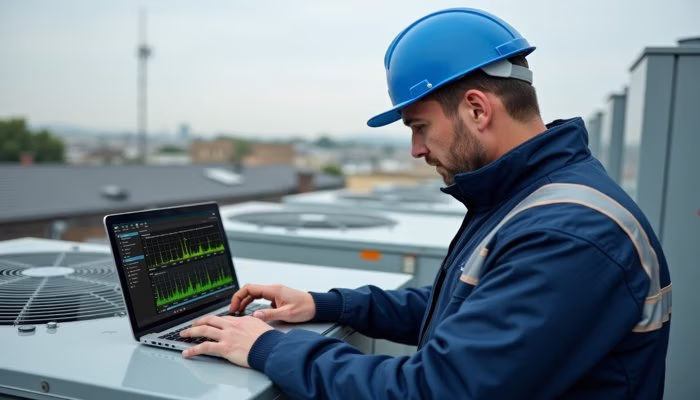Summary: Remote maintenance is rapidly becoming essential in industries worldwide, from manufacturing plants to field service operations. The digital revolution has significantly transformed how maintenance processes are handled, enabling companies to remain efficient, cost-effective, and adaptable. However, transitioning to a fully remote maintenance system isn’t without its hurdles. These challenges can range from technical issues to human factors, all of which can complicate the process. The good news is that advanced digital tools and solutions are here to address these obstacles, turning them into opportunities for improvement.
In this article, we’ll dive deep into the common challenges of remote maintenance and how digital solutions, like IoT sensors, augmented reality (AR), and integrated platforms, can streamline the process. We will also offer actionable tips for successfully implementing these tools in your operations.
Shifting to Proactive Remote Maintenance
Historically, maintenance work required technicians to be physically present on-site, leading to costly downtime, extended service intervals, and potentially severe operational disruptions. With the advent of digital technology, this paradigm is shifting toward more proactive, real-time approaches to equipment maintenance.
The foundation of this shift can be attributed to two core factors: efficiency and cost-effectiveness. By leveraging remote maintenance solutions, businesses can minimize downtime, reduce maintenance costs, and ensure the longevity of critical machinery and equipment. In addition, these solutions provide a sustainable, eco-friendly approach to maintenance by reducing the need for on-site visits and the carbon footprint associated with travel.
While these advancements offer clear benefits, implementing remote maintenance comes with its own set of challenges.
How can you optimize your remote maintenance processes?
With flowdit, you can streamline inspections, ensure compliance, and track issues in real-time across your operations.
Addressing the Core Pain Points of Remote Maintenance
1. Limited Access to On-Site Equipment
In traditional maintenance setups, technicians can access equipment easily, diagnosing and resolving issues on the spot. However, remote maintenance eliminates this immediacy. Without physical presence, diagnosing and repairing issues can become difficult.
Solution: Digital Diagnostics and Remote Monitoring
Digital tools, such as real-time monitoring systems and IoT sensors, enable technicians to collect continuous data from machinery. Sensors measure key performance metrics, such as temperature, vibration, and pressure, and send this data to centralized systems. This enables remote diagnostics, allowing teams to identify and address issues promptly.
Key Benefits:
Faster issue detection and diagnosis.
Proactive maintenance to prevent unplanned breakdowns.
Recommended Tools:
IoT Sensors: For real-time performance tracking.
Remote Monitoring Platforms: Software that aggregates sensor data and provides actionable insights. flowdit is a remote-enabled CMMS solution that integrates real-time monitoring and diagnostics.
2. Lack of Skilled Technicians on-Site
Remote maintenance often occurs because technicians cannot be physically present due to location, availability, or travel restrictions. This shortage of skilled workers on-site can impede maintenance tasks and impact operational efficiency.
Solution: Augmented Reality (AR) and Remote Assistance
Augmented reality (AR) technology can bridge the skills gap. Using AR-powered devices, such as smart glasses or mobile devices, technicians can receive step-by-step visual instructions for maintenance tasks. Additionally, remote support can be provided by experts through video calls, offering real-time guidance and troubleshooting.
Key Benefits:
Real-time, hands-on support for technicians.
Training opportunities for less experienced workers.
Recommended Tools:
AR-powered Apps: Apps like Google Glass provide visual support for complex maintenance tasks.
Video Conferencing: Platforms such as Zoom or Microsoft Teams enable live consultations. flowdit enables remote assistance and video consultation features for technicians.
3. Communication Barriers
Effective communication is critical in remote maintenance. Without physical presence, teams may struggle to relay vital information or correctly diagnose problems, leading to delays in resolution.
Solution: Collaborative Platforms and Instant Messaging
Digital communication platforms enable seamless interaction between remote and on-site teams. These tools facilitate real-time sharing of data, photos, and videos, ensuring that everyone has access to the same information, reducing misunderstandings and speeding up decision-making.
Key Benefits:
Instant, clear communication and connectivity, regardless of location.
Visual aids like photos and videos for better issue explanation.
Recommended Tools:
Messaging Apps: Platforms such as Slack or Microsoft Teams for instant communication.
Collaboration Platforms: Tools like Trello or Asana to keep teams organized and aligned. flowdit is a centralized platform for sharing maintenance data, images, and updates between remote and on-site teams.
4. Managing Multiple Systems Across Departments
Large organizations often deal with complex maintenance tasks that span various systems, teams, and departments. Managing these systems remotely can be challenging, leading to inefficiencies and errors.
Solution: Integrated Maintenance Management Software (CMMS)
A centralized platform, such as a Computerized Maintenance Management System (CMMS) for managing machines or systems, integrates all maintenance data, schedules, and tasks. This ensures that teams can work collaboratively, avoid duplicate efforts, and track maintenance activities from a single interface.
Key Benefits:
Centralized data management for easy access and tracking.
Improved resource allocation, ensuring the right technician is assigned to the right task.
Recommended Tools:
CMMS Platforms: Examples include UpKeep, Fiix, and Maintenance Connection for effective remote control of equipment. flowdit is an integrated CMMS solution that centralizes maintenance tasks, data, and scheduling, offering both on-site and remote access.
5. Security Risks in Remote Access
When transmitting maintenance data over the internet, businesses expose themselves to potential cybersecurity threats. Protecting this data is essential to safeguard business operations and comply with industry regulations.
Solution: Enhanced Security Protocols
To mitigate security risks, digital maintenance solutions incorporate advanced encryption, multi-factor authentication (MFA), and secure virtual private networks (VPNs) to protect data during transmission. Implementing robust security measures ensures that only authorized personnel can access critical data.
Key Benefits:
Safeguarded data transmission.
Compliance with industry security standards and regulations.
Recommended Tools:
VPNs and Firewalls: To secure data exchanges.
Encrypted Communication Tools: Look for platforms that provide end-to-end encryption. flowdit integrates multi-factor authentication and encryption to ensure secure remote maintenance operations.
6. Tracking and Reporting Maintenance Performance
Without real-time tracking, evaluating the performance of remote maintenance efforts can be difficult. Without clear oversight, it’s challenging to determine the effectiveness of maintenance tasks and identify areas for improvement.
Solution: Digital Dashboards and Analytics Tools
Digital dashboards and analytics tools consolidate performance data from various sources, allowing teams to track key performance indicators (KPIs) such as equipment uptime, maintenance costs, and downtime. These insights enable data-driven decision-making, improving overall efficiency.
Key Benefits:
Data-driven insights for better decision-making.
Easy identification of maintenance bottlenecks or inefficiencies.
Recommended Tools:
Analytics Software: Power BI or Tableau can provide detailed, real-time reports on maintenance and monitoring metrics. flowdit offers a comprehensive dashboard for tracking and visualizing maintenance KPIs, providing real-time insights into operational efficiency.
Conclusion
Remote maintenance presents several challenges, but with the right digital solutions, businesses can overcome these obstacles, improving both efficiency and cost-effectiveness. IoT sensors, AR tools, communication platforms, and integrated CMMS systems enable organizations to enhance their remote maintenance operations, reduce downtime, and increase productivity.
If you're looking to revolutionize your maintenance processes and stay ahead of potential issues, consider implementing digital tools like flowdit. Our platform offers an integrated solution that ensures seamless remote inspections, real-time diagnostics, and enhanced team collaboration.
Ready to take your maintenance operations to the next level? Learn more about flowdit
FAQ | Remote Maintenance
What is remote maintenance and how does it work?
Remote maintenance refers to the ability to perform maintenance tasks on equipment or systems from a remote location, without the need for a technician to be physically present. This is typically enabled by digital solutions such as remote desktop tools, remote monitoring systems, and remote support software. These technologies enable technicians to monitor and maintain systems, diagnose issues, install software updates, and implement preventive measures, providing real-time information to minimize downtime and enhance efficiency.
What are the key digital solutions for remote maintenance?
Key types of remote maintenance include IoT and sensor technology, cloud-based platforms, augmented reality (AR) for remote support, and drones for remote inspections. These technologies enable real-time monitoring, predictive analytics, and increased visibility, helping maintenance teams stay ahead of potential issues and improve efficiency.They provide technical support by offering remote troubleshooting and expert guidance when needed.
What are the benefits of remote maintenance?
Increased Efficiency: Real-time monitoring and diagnostics minimize downtime and speed up issue resolution.
Cost Reduction: Eliminates travel time and on-site visits, Eliminates travel time and on-site visits, and associated travel expenses, while predictive tools help avoid costly repairs.while predictive tools help avoid costly repairs.
Data-Driven Insights: Continuous data collection enables informed decisions, optimizing maintenance and extending asset life.
Enhanced Safety: Minimizes technician exposure to hazardous environments.
- Business Continuity: Ensures that IT operations can persist during disasters, including outages, natural events, or restrictions on physical access.
Scalability: Manage multiple assets across locations without compromising service quality.
How do IoT and sensor technologies enhance remote maintenance?
IoT sensors embedded in equipment continuously collect data on various performance metrics, such as temperature, pressure, vibration, and usage. This data is analyzed to detect signs of wear or impending failures, enabling proactive maintenance. This approach allows teams to address issues before breakdowns occur, minimizing unplanned downtime.
What role do drones play in remote inspections for maintenance?
Drones equipped with high-definition cameras and sensors are used for remote visual inspections, especially in difficult-to-reach or hazardous environments. They can cover large areas quickly, providing detailed and frequent checks. Drones reduce the need for scaffolding or ladders, improving safety and ensuring regular inspections in industries like oil and gas, utilities, and construction.
How is Augmented Reality (AR) applied in remote maintenance?
Augmented Reality (AR) provides real-time guidance to technicians in the field using AR glasses or mobile devices. It overlays visual instructions for equipment diagnostics, repairs, or troubleshooting. This enables remote experts to interact live with field technicians, offering support without needing to be physically present, which reduces response times and improves the accuracy of repairs.
How can remote maintenance solutions integrate with commissioning systems to streamline startup?
Remote maintenance solutions can seamlessly integrate with commissioning systems to provide real-time data analytics, offering insights into equipment health, operational readiness, and potential failures. This integration enables quicker decision-making, reduces system validation time, and enhances troubleshooting efficiency by providing immediate access to diagnostic data remotely.
What benefits do cloud-based platforms provide for remote maintenance management?
Cloud-based platforms allow remote monitoring and management of assets from anywhere in the world. They offer dashboards that display key performance indicators, maintenance schedules, and work order management. These platforms enable seamless collaboration among teams, scalability for businesses with multiple sites, and secure storage of historical performance records, facilitating quick access to data and reports.
How can maintenance logs be efficiently managed in the cloud?
Cloud-based platforms centralize maintenance logs, enabling real-time updates, automated data entry, and seamless team collaboration. They offer scalable storage, advanced analytics, and easy access from anywhere, ensuring accurate and efficient management of maintenance records.
How can organizations ensure secure remote access?
To ensure secure remote access, organizations should implement robust security measures, such as encryption, multi-factor authentication, and regular software updates. Using trusted remote maintenance solutions that comply with industry standards can further enhance security. Additionally, training employees on cybersecurity best practices is crucial to prevent unauthorized access and mitigate the risk of cyberattacks and safeguard sensitive data.
How do cloud-based platforms enhance data accessibility during commissioning?
Cloud-based platforms allow centralized storage and access to commissioning data, which enables global teams to monitor equipment status and performance metrics in real time. These platforms provide advanced reporting features, including historical data analysis, trend forecasting, and compliance tracking.
Image: Adobe Stock – Copyright: © Vera – stock.adobe.com





